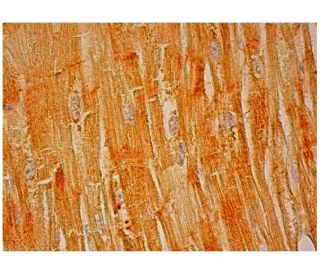



FSD2 Antibody (H-11): sc-393072
- FSD2 Antibody (H-11) is a mouse monoclonal IgG1 κ FSD2 antibody provided at 200 µg/ml
- specific for an epitope mapping between amino acids 22-45 near the N-terminus of FSD2 of human origin
- FSD2 Antibody (H-11) is recommended for detection of FSD2 of mouse, rat and human origin by WB, IP, IF, IHC(P) and ELISA
- Anti-FSD2 Antibody (H-11) is available conjugated to agarose for IP; HRP for WB, IHC(P) and ELISA; and to either phycoerythrin or FITC for IF, IHC(P) and FCM
- also available conjugated to Alexa Fluor® 488, Alexa Fluor® 546, Alexa Fluor® 594 or Alexa Fluor® 647 for WB (RGB), IF, IHC(P) and FCM, and for use with RGB fluorescent imaging systems, such as iBright™ FL1000, FluorChem™, Typhoon, Azure and other comparable systems
- also available conjugated to Alexa Fluor® 680 or Alexa Fluor® 790 for WB (NIR), IF and FCM; for use with Near-Infrared (NIR) detection systems, such as LI-COR®Odyssey®, iBright™ FL1000, FluorChem™, Typhoon, Azure and other comparable systems
- m-IgG Fc BP-HRP, m-IgG1 BP-HRP and m-IgGκ BP-HRP are the preferred secondary detection reagents for FSD2 Antibody (H-11) for WB and IHC(P) applications. These reagents are now offered in bundles with FSD2 Antibody (H-11) (see ordering information below).
QUICK LINKS
SEE ALSO...
FSD2 Antibody (H-11) is a mouse monoclonal IgG1 kappa light chain antibody that detects FSD2 protein of mouse, rat, and human origin by western blotting (WB), immunoprecipitation (IP), immunofluorescence (IF), immunohistochemistry with paraffin-embedded sections (IHCP), and enzyme-linked immunosorbent assay (ELISA). Anti-FSD2 antibody (H-11) is available in both non-conjugated and various conjugated forms, including agarose, horseradish peroxidase (HRP), phycoerythrin (PE), fluorescein isothiocyanate (FITC), and multiple Alexa Fluor® conjugates. FSD2, also known as fibronectin type III and SPRY domain-containing protein 2 or SPRYD1, is a 749 amino acid protein characterized by one B30.2/SPRY domain and two fibronectin type-III domains, which play crucial roles in cellular signaling and adhesion. The presence of these domains facilitates protein-protein interactions essential for various biological processes, including cell differentiation and immune response. The gene encoding FSD2 is located on human chromosome 15q25.2, a region harboring over 700 genes and implicated in several genetic disorders, such as Angelman and Prader-Willi syndromes, highlighting FSD2′s importance in maintaining normal cellular functions and potential role in disease mechanisms.
Alexa Fluor® is a trademark of Molecular Probes Inc., OR., USA
LI-COR® and Odyssey® are registered trademarks of LI-COR Biosciences
FSD2 Antibody (H-11) References:
- Analysis of the DNA sequence and duplication history of human chromosome 15. | Zody, MC., et al. 2006. Nature. 440: 671-5. PMID: 16572171
- Effective gene therapy in an authentic model of Tay-Sachs-related diseases. | Cachón-González, MB., et al. 2006. Proc Natl Acad Sci U S A. 103: 10373-10378. PMID: 16801539
- Pyrimethamine as a potential pharmacological chaperone for late-onset forms of GM2 gangliosidosis. | Maegawa, GH., et al. 2007. J Biol Chem. 282: 9150-61. PMID: 17237499
- Molecular epigenetics of Angelman syndrome. | Lalande, M. and Calciano, MA. 2007. Cell Mol Life Sci. 64: 947-60. PMID: 17347796
- [The Prader-Willi syndrome]. | Diene, G., et al. 2007. Ann Endocrinol (Paris). 68: 129-37. PMID: 17499572
- Detailed analysis of 15q11-q14 sequence corrects errors and gaps in the public access sequence to fully reveal large segmental duplications at breakpoints for Prader-Willi, Angelman, and inv dup(15) syndromes. | Makoff, AJ. and Flomen, RH. 2007. Genome Biol. 8: R114. PMID: 17573966
- Fibrillin-rich microfibrils: Structural determinants of morphogenetic and homeostatic events. | Ramirez, F. and Dietz, HC. 2007. J Cell Physiol. 213: 326-30. PMID: 17708531
- Extracellular control of TGFbeta signalling in vascular development and disease. | ten Dijke, P. and Arthur, HM. 2007. Nat Rev Mol Cell Biol. 8: 857-69. PMID: 17895899
Ordering Information
| Product Name | Catalog # | UNIT | Price | Qty | FAVORITES | |
FSD2 Antibody (H-11) | sc-393072 | 200 µg/ml | $316.00 | |||
FSD2 Antibody (H-11): m-IgG Fc BP-HRP Bundle | sc-530345 | 200 µg Ab; 10 µg BP | $354.00 | |||
FSD2 Antibody (H-11): m-IgGκ BP-HRP Bundle | sc-523793 | 200 µg Ab, 40 µg BP | $354.00 | |||
FSD2 Antibody (H-11): m-IgG1 BP-HRP Bundle | sc-544001 | 200 µg Ab; 20 µg BP | $354.00 | |||
FSD2 Antibody (H-11) AC | sc-393072 AC | 500 µg/ml, 25% agarose | $416.00 | |||
FSD2 Antibody (H-11) HRP | sc-393072 HRP | 200 µg/ml | $316.00 | |||
FSD2 Antibody (H-11) FITC | sc-393072 FITC | 200 µg/ml | $330.00 | |||
FSD2 Antibody (H-11) PE | sc-393072 PE | 200 µg/ml | $343.00 | |||
FSD2 Antibody (H-11) Alexa Fluor® 488 | sc-393072 AF488 | 200 µg/ml | $357.00 | |||
FSD2 Antibody (H-11) Alexa Fluor® 546 | sc-393072 AF546 | 200 µg/ml | $357.00 | |||
FSD2 Antibody (H-11) Alexa Fluor® 594 | sc-393072 AF594 | 200 µg/ml | $357.00 | |||
FSD2 Antibody (H-11) Alexa Fluor® 647 | sc-393072 AF647 | 200 µg/ml | $357.00 | |||
FSD2 Antibody (H-11) Alexa Fluor® 680 | sc-393072 AF680 | 200 µg/ml | $357.00 | |||
FSD2 Antibody (H-11) Alexa Fluor® 790 | sc-393072 AF790 | 200 µg/ml | $357.00 | |||
FSD2 (H-11) Neutralizing Peptide | sc-393072 P | 100 µg/0.5 ml | $68.00 |
